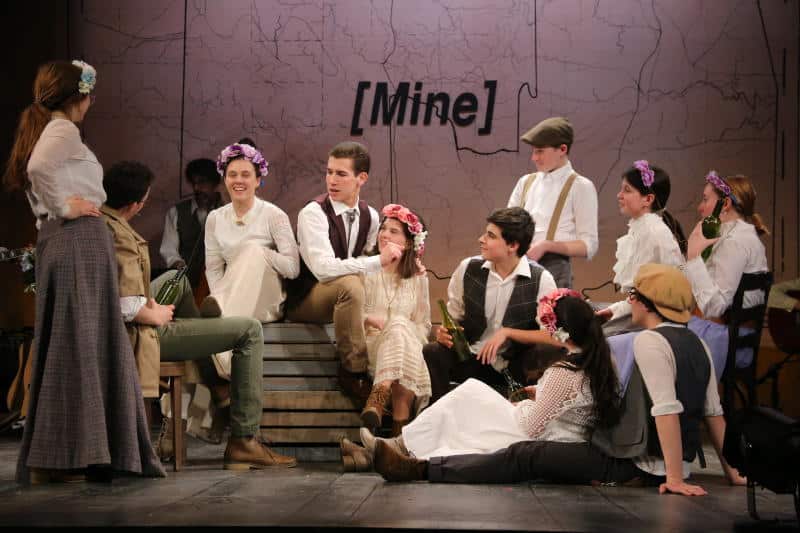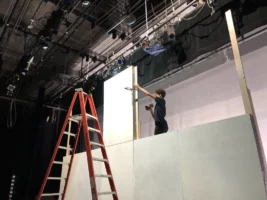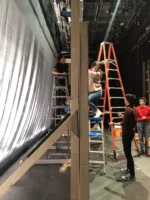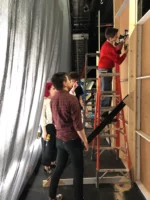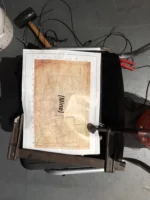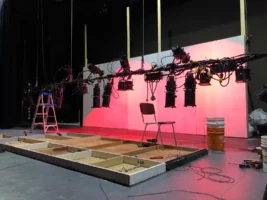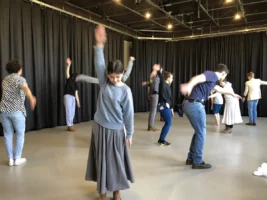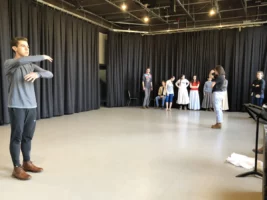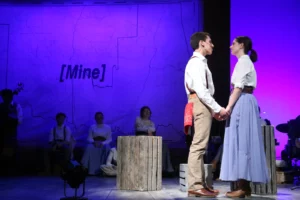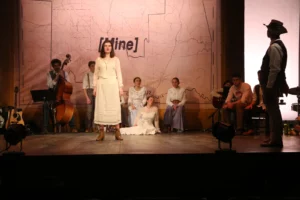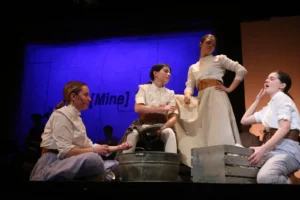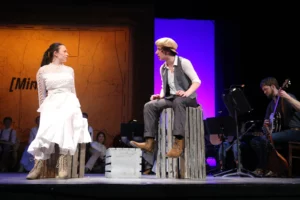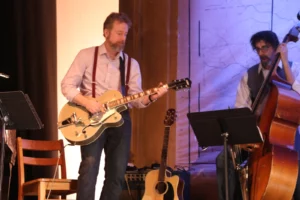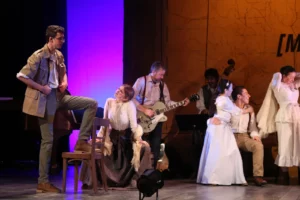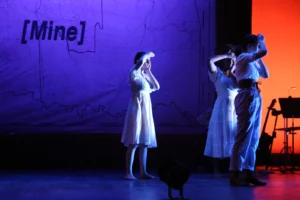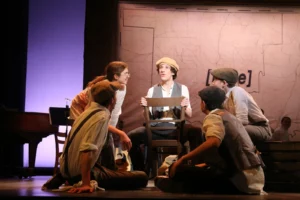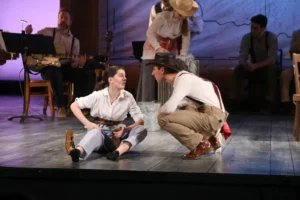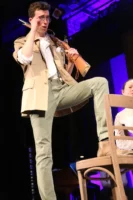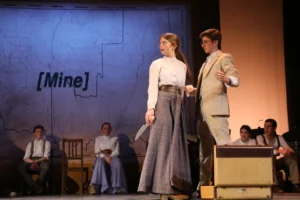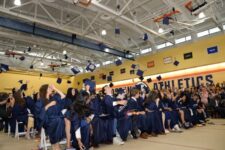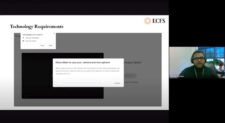Before the audience took their seats in the Fieldston auditorium, before the first lights illuminated the set, before the cast — electric and exhilarated — took their places and steadied themselves for their first cues, Matthew C. ’19 towered above the stage, power drill in hand, building the world the audience would soon experience during the ECFS production of “Oklahoma!”.
“It’s knowing that people will look at the set and think, ‘that’s an interesting choice.’ And knowing I was part of creating it — that’s what I really love about set design,” said Matthew, who worked alongside Emmie Finckel ’10, Set Designer and faculty member, as the Assistant Set Designer for the spring musical.
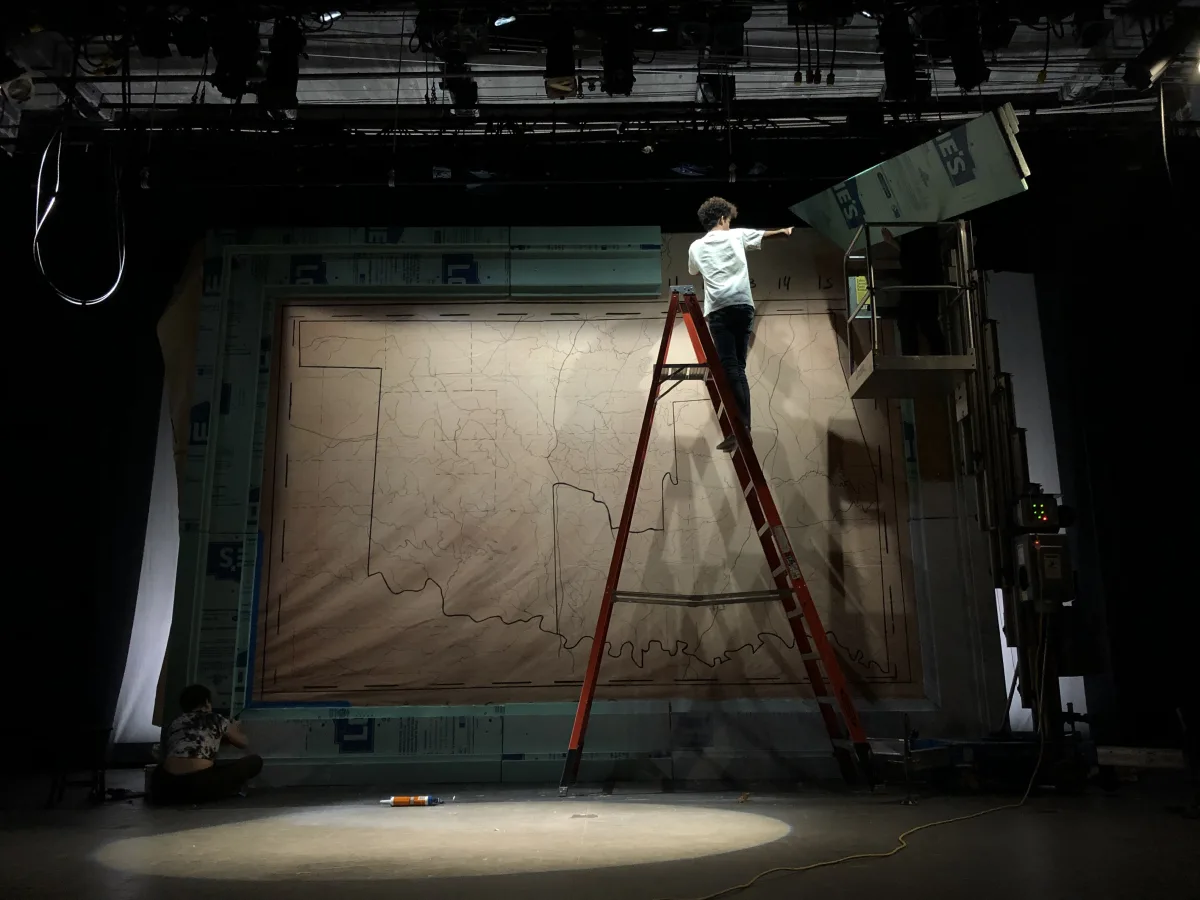
One afternoon in February, Matthew worked alongside several other students during tech lab, a class, taught by Finckel, in which students both design and build theatrical sets. Several students in the class were also in the cast of “Oklahoma!”. A few of the students were enrolled in a later session of tech lab, but chose to spend their free hour of the day working on the set. Matthew mentioned that several of them planned to spend Presidents’ Day, when school would be closed, on the stage, catching up for time they missed due to a recent snow day.
That afternoon, the students and Finckel were building the 14’ x 20’ picture frame that would hold a map of Oklahoma. The map itself was draped across the middle rows of the audience, waiting to be put into place. When asked if he was worried about getting the massive piece of fabric onto the wall, Matthew laughed, “Not really. We’ve done harder things.”
A strong sense of teamwork unified the students building the set. As Eva B. ’22 climbed a ladder to help Matthew put another piece of plywood into place, she was visibly nervous. But her classmates stood behind her, holding the ladder steady and talking her through the motions. She climbed to the top without much hesitation.
“It’s nice, after a day of academic classes, to do something with your hands. And it’s also a collaborative effort, which is different from a lot of visual arts.” Eva said once she was back on the ground.
“There’s something really cool about building something, seeing it come to life, then seeing the actors use it.” Added Harper L. ’19, before taking Eva’s place on the ladder.
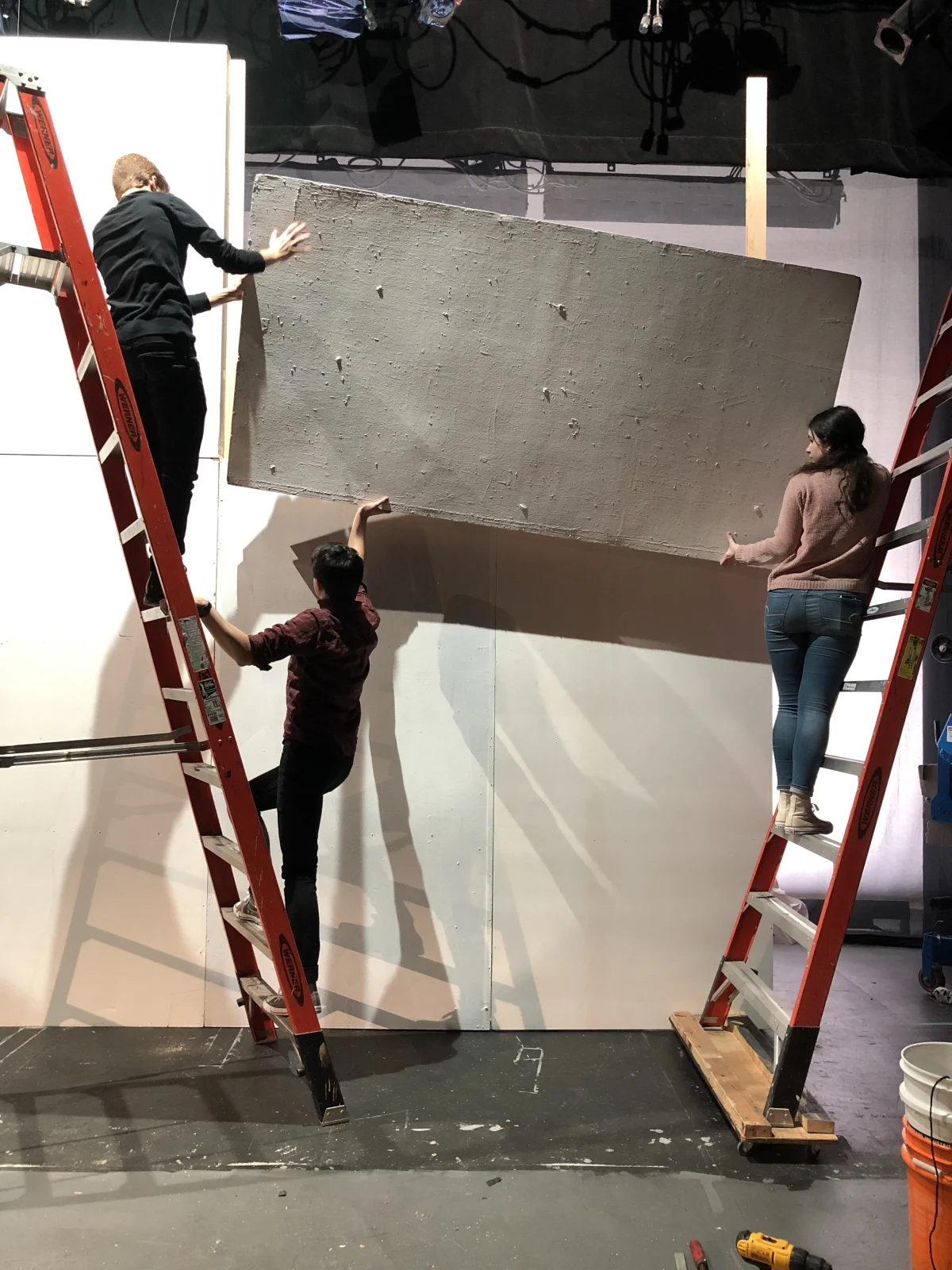
The students were in constant motion, climbing up and down ladders, lifting large slabs of wood, walking back and forth across the stage, disappearing and returning from behind the curtain. The relentless roar of power tools filled the theater; students shouted directions to each other over the noise. It was a controlled chaos, with students manning the madness.
The set design for “Oklahoma!” was one of the most unique aspects of the production. When asked to describe what the word [MINE], painted over the map, signified, Matthew explained that it “relates to the idea of expansion and Manifest Destiny of white settlers.” The show, written in 1943 but set in 1906 — the year Oklahoma became a state — has not traditionally engaged with the darker realities of the time period: the Trail of Tears, The Dawes Act, the Tulsa Riots. But the ECFS version flipped the show on its head. “What this play is actually saying,” Matthew continued, “is a narrative of what America really was. People were taking land. They wanted it, so they just took it. It was mine.”
Matthew wasn’t concerned about any potential backlash or negative reaction to the set. “If there is, then I hope they learn and think about why that is.”
The set design was not the only way the ECFS production highlighted the realities of Oklahoma in 1906. The musical’s score is typically played by a full orchestra. But for this show, the only instruments used — save for the electric guitar — were ones that could be found in Oklahoma at the turn of the century: banjo, mandolin, fiddle, upright bass, an out of tune piano.
Before a rehearsal in early February, William Norman, faculty member and the show’s Musical Director, sat at his desk, one leg crossed casually over the other, guitar in hand. He strummed a few chords; he was trying to work out a tricky harmony. “A chord that would normally be played by an entire orchestra is now being recreated on a single instrument.” He said, plucking at a few strings.
“There’s a familiarity, but it’s also different,” was how he described the experience of listening to the songs played on so few instruments. As with any good musical, the score reflected the themes of the show. For ECFS, this meant highlighting the darkness and the difficult conversations lurking beneath the surface of “Oklahoma!”. In the end, the production was something familiar, but it was also something entirely new.
One challenge that Norman faced while adapting the music to be played on folk instruments was the risk of sounding “too precious,” which would contrast the way the story was being told. “There’s some ugliness in the time period and we’re focusing on that.” Norman decided to bring in the electric guitar to highlight that “ugliness.”
In the end, the music reflected the overall goal of the production: to contrast the new with the old, to shed a unique light on a story we thought we knew. “We’re giving the story a more contemporary and modern understanding,” said Norman.
At a dance rehearsal towards the end of February, Ava Heller, faculty member and one of the show’s two choreographers, led a dancer through her transitions as William Norman and a few student musicians practiced their cues. Actors were scattered across the sun-lit room, tying laces on their stage shoes, rehearsing steps of the upcoming number, and finishing up homework. Jami S. ’20, one of the assistant stage managers, sat ripping up an old sheet for the dancers to use as sweat rags.
“Don’t worry so much about the counts, but feel the movements flow through you along with the music.” Ava told the dancer.
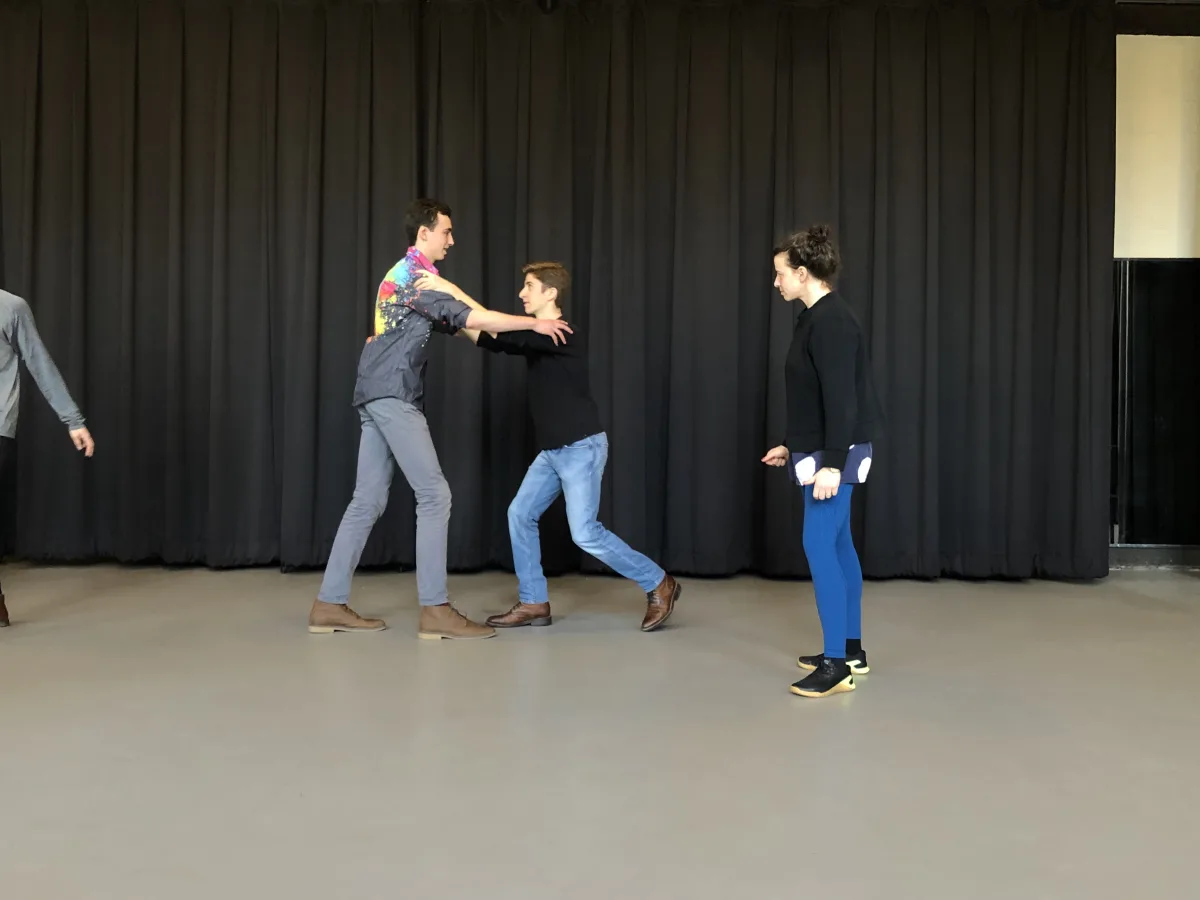
The afternoon was spent working on the dream ballet, the impressive ensemble dance piece that occurs at the midway point of the show. During rehearsal, Ava watched the performers and made decisions based on their movements. At one point, a few of the actors expressed their concerns about completing all of the steps in a sequence on time. Ava joined them, walking through each motion, eventually deciding to update the choreography to allow them more time.
Once again, the ECFS production of “Oklahoma!” broke with tradition in order to engage with a more complex narrative during the dream ballet.
“It feels darker, more fluid.” Said Sam H. ’19, who played Will Parker in the show.
In traditional tellings of “Oklahoma!,” including the 1955 film, the dream ballet takes Laurey Williams (played by Claudia B. ’19) through a slanted version of the story. She frets over her relationship with Curly (played by Andy H. ’19); she decides to marry him; she fears retaliation from Jud Fry (played by Asher S. ’19), who ends up murdering Curly in the dream. When it came time for Ava to choreograph her version of the dream ballet, she chose to move away from such straightforward images and narrative.
“I think of dreams as taking a literal idea and turning it on its head.” Ava said. “I wanted the dance to be more about a feeling in the space, creating an energy in the space.”
To achieve this, Ava updated the ballet to incorporate more modern dance. She had the actors waltz — a traditional style from the time — but everyone danced alone, each actor turning in different directions to create a sense of chaos and unreality.
“Dance can speak in a language that doesn’t have to be literal and still convey meaning.” Ava explained.
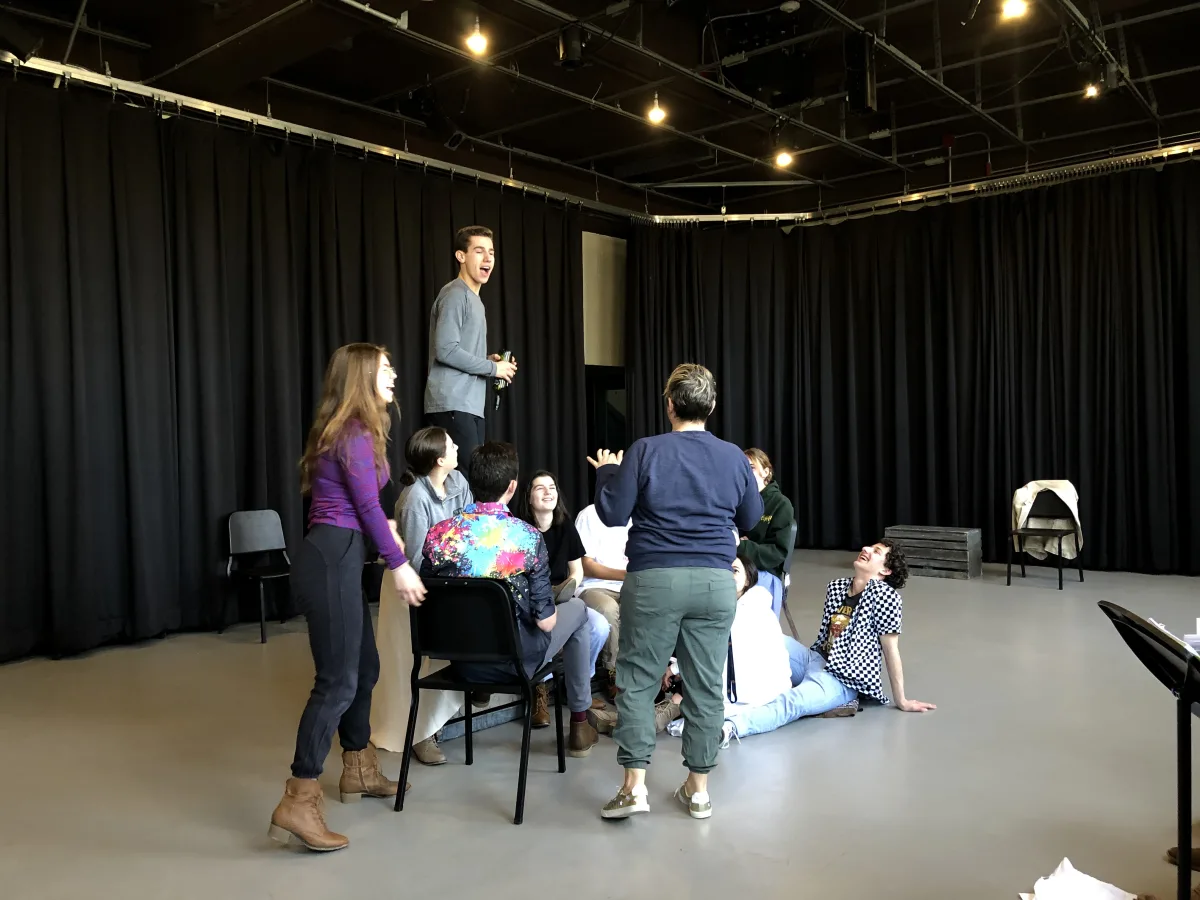
At rehearsal, students ran through the dance nearly a dozen times. Laughter and chatter filled the room during breaks, but as soon as the music started, everyone fell silent to focus on the work at hand.
“I love their dedication.” Ava said of ECFS students. “The actors have already developed such a high level of respect for what they’re doing, that when I come in, they’re ready to work.”
Building a set, learning the music, practicing choreography — all activities one would expect from students participating in a musical production. But what about reading through multiple dialect dictionaries to analyze the language used in the script? Researching the Dawes Act in order to explain the historical and cultural significance in relation to the time period of the story? Writing analytical essays and explaining your findings to the cast? “Oklahoma!” dramaturg Jax B. ’19 did all of these, and more, to help the cast perform their roles with as much knowledge and nuance as possible.
“When approached the way we’ve approached it, “Oklahoma!” is an extremely complex show,” explained Jax.
The complexity was evident through the unique set design, the contrasting instrumentals, the infusion of modern dance, and the nuanced performances by the actors. Behind all of these was the research conducted and explained by Jax.
“I’ve done so much research and I’ve learned so much about this.” Jax said, shortly before the final dress rehearsal. “And now I’m seeing everything that I told them about in the beginning come to life. I’m so proud of this cast.”
During an early rehearsal, Clare Mottola, the show’s Director and Chair of the Theater and Dance Department, asked the cast a simple question: “Why do we do run-throughs?”
“It forces you to think of transitions and how to transition smoothly.” Said Andy.
“We work out of order; now we put it in order.” Added Sam.
“To get a sense of how everything fits together.” Thomas G. ’19 said.
For the ECFS production of “Oklahoma!,” there were many pieces that needed to fit together. The cast was responsible for absorbing the many contradictions within and surrounding the show, carrying them in their performances, and conveying to the audience all of the complexity and nuance at work. Mottola made the decision to keep the entire cast and the musicians on stage for the duration of the show. Because of this, the audience could never forget that they were witnessing a performance. Escapism was not the goal.
“Art should never be a reprieve. Not at Fieldston,” explained Mottola.
The final moments of “Oklahoma!” are traditionally joyful. Laurey and Curly are wed, Curly kills Jud but is immediately cleared of all charges, and the couple departs for their honeymoon, wide-eyed and ready to fulfill their destiny to thrive in the new land.
The finale to the ECFS production instead highlighted the cruelty and privilege of these characters. The music cut, the lights faded slowly. For the first time, the actors and musicians cleared the stage, drawing the eye once more to that loaded [MINE]. Laurey was left alone, singing the last, somber note.
Yet, despite the grim nature of the finale, there remained in the theater the inevitable joy and wonder that occurs when a group of people who are all deeply passionate about their work have completed something miraculous. The ECFS production of “Oklahoma!” was certainly a team effort, and the triumph of the team was palpable in the Fieldston auditorium.
